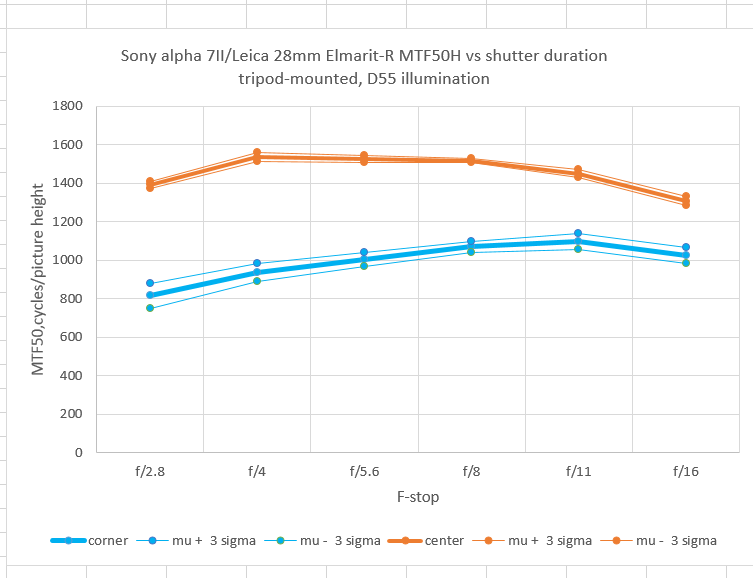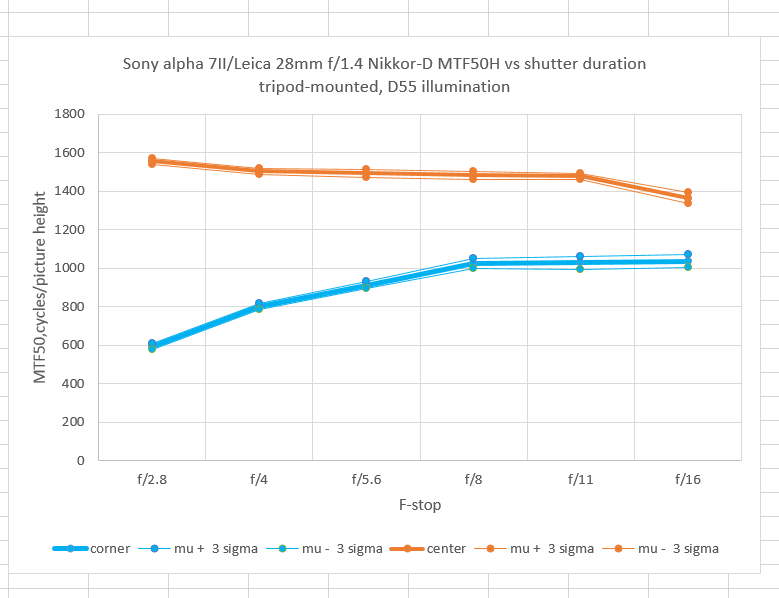The Coastal Optical 60mm is a great lens for infrared, but it’s too long for a lot of landscape use. I’m shooting handheld around the house, and I don’t like to do double-row stitches that way. So I’m looking for something wider.
28mm is a nice focal length for landscape. It’s probably the most versatile wide angle lens for me. Why not the 35? I don’t have anything against that focal length; I just don’t consider it a wide angle lens. The diagonal of the 35mm format is 43mm, so 35 is a wide normal lens, and 50 is a long normal lens, the way I look at it.
I set out to test three candidates. I will eventually get around to testing them in the infrared, but I’m waiting for some filters to arrive. I figure if they’re bad in visible light, they won’t be any good in IR, and if they’re good in visible light, they might be good in IR.
The first lens is the Leica 28mm f/2.8 Elmarit-M ASPH. This is truly a long shot, since it’s had bad corner smear on every alpha 7 camera I’ve tested it with. The next is its R-series brother, the Leica 28mm f/2.8 Elmarit-R. The M-series lens is of 2013 vintage, with all the fancy stuff that modern optical engineers can do. The R-series lens is from the 1980s. The third lens is also an older one: the Nikon 28mm f/1.4 D. This lens has a great reputation, and, after Nikon discontinued it, sold on eBay for way more than its original sale price.
The test protocol:
I mounted a RRS L-plate to the a7II, clipped it in landscape orientation into an Arca Swiss C1 head which was attached to a set of RRS TVC-44 legs. I focused all the lenses at f/2.8. I lit an Imatest SFRPlus target with a Paul Buff Einstein strobe set to 2.5 watt-seconds, for the f/2.8 shots, 5 ws for the f/4 ones, 10 ws for the f/5.6 ones, following that progression until I got to f/16. the narrowest opening shared by all three lenses. I set the ISO to 100, the shutter speed to 1/125 second, the shutter mode to 3-second delay and electronic first curtain shutter (EFCS). I made a series with the target in the center, and one with the target in the upper right corner, focusing on it in each location.
I developed the images in Lightroom 5.7.1 with default settings, exported them as TIFFs, and measured on-axis MTF50 in both the vertical direction — horizontal edges.
The M-series Elmarit:
The center is pretty good, but the corners are awful at wide apertures, becoming acceptable at f/11, where the center is beginning to roll off. If I were to use this lens on this camera for landscapes I’d be stuck with f/11 all the time.
The R-series Elmarit:
A little better in the center, and a lot better in the corner. Looks like a winner in visible light.
The Nikon:
The center performance at f/2.8 is incredible. The corner, not so much. It looks about the same as the Leica R lens at the other apertures.
So far, I have two winners. I think for most uses, the Elmarit-R is the better lens — smaller, lighter. The Series VII filter is a pain, though.
[Added 2/22/15: The Elmarit-R has a lot more artifacts when the sun is in the frame, and more flare in general, than the Nikkor. I’m now using the Nikkor for IR work in preference to the Leica.]



Thanks Jim,
it confirmes again how good the old lenses are! And how good the newer digital cam can manage it! I agree 28mm is very good for landscape. The Leica M gives a pleasant vinetting by shooting….:)
Hi Jim, great comparison. I am a little surprised at how flat the curves are in the lower f-numbers (I’d expect significant peaks around f/5.6) and I wonder whether the cause could be focus shift: if I understand correctly focus is only set once per lens at f/2.8 (curious how you focus btw).
Have you tried seeing what performance is obtained when acquiring focus at every f-number change? Jack
Jack, I haven’t done that. There are several reasons. First, each of the lenses is designed to be used in an environment in which focus shift would be hugely detrimental. The M-series lens is designed for an rangefinder camera, and the other two are designed for SLRs. The second reason is the way that I use lenses like these on mirrorless cameras. I focus wide open, then stop down. I find focusing at the shooting aperture gives me inconsistent — and generally much poorer — results.
The third reason is being easily bored and adverse to pain. My focusing results at small apertures are so inconsistent that I’d have to refocus for every exposure to get some statistical significance. There were almost 600 (6×96) exposures required to get the data for the three graphs in this post.
I’ll do a check with one of the lenses. Which one would you pick?
As to how I focus, I use maximum magnification on the Siemens star, and tune for biggest red fungus radius. If there’s no red fungus, I go for maximum sharpness.
Jim
Sounds good Jim. I’d pick the Nikkor. Jack
Jim, very interesting tests! How much of the Nikon’s results do you think is affected by field curvature?
None, since I focused the corner images independently of the center ones.
Jim
Hi Jim,
Great and useful comparisons.
I’m thinking to buy an A7 in order to reuse my Contax G2 Zeiss lenses (I have an 28, 45 and 90mm). My preferred focal is 28 and I know that the alphas have problems (vignetting, etc…) . Well, I’m in a doubt because I’ve read many sites with reviews telling that the A7s is the better with rangefinder wide angle lenses. But in your review about the Leica 28 it seems that it’s not true. Well, since the A7II is cheaper and have some interesting features, like IBIS, could be a valid option. Maybe my G2 Zeiss 28 is not perfect on the 7S, and then If I find a good 28mm (Zeiss or Leica) for the A7II I can go for that. Could you give any suggestion or opinion ? Thank you very much!
Corner smearing is a function of the sensor stack thickness in the a7x cameras, and will be the same no matter which one you choose, although the higher res cameras will show it more on a per pixel basis.
Corner color casting gets worse as the resolution goes up, so the a7S will have the least problems.
As to 28s that work on the a7x cameras, all the SLR lenses I’ve tested are OK.
Jim
Thank you Jim!
Another couple of your opinions:
– Did you make test with 35mm rangefinder lenses and the A7’s? Is there difference between A7S and A7II?
– Without considering the high performance in low light and video of the Alpha 7S, and thinking that Zeiss could make a 28 mm specific to the Full Frame bodies (as Loxias, for instance), do you think that the A7II could be a more useful camera for stills and street photography?
Thanks again,
Alex
The a7S and a7II will exhibit the same amount of corner smear, although the a7S will not resolve the smear as well. The a7S is less prone to corner color casts.
The answer to your question about the a7S vs the a7II in the street has to do with how dark it is and how big you print. If subject motion is not an issue, the IBIS on the a7II will more than compensate for the lower high-ISO noise of the a7S.
Jim
I’m working on a 35mm lens test on the a7II.
Great! I will wait for your tests! In a mean time I was checking what adapter could be nice for my Zeiss G2 Lenses in the A7’s
I’ve read many different opinions about Metabones, Kipon, Fotodiox and Fotasy. I tried to check if Novoflex has this adapter, I found one for NEX, but I don’t know if it will work on the A7.
Do you have a suggestion or opinion for me?
Thanks again 🙂
Regards
Kipon is my first choice. Novoflex second. The NEX adapter will work on the a7.
What about the Zeiss 28mm F2 Distagon ZF?
I use this lens on my Sony A7II and it is perfect.
It is big and heavy of course, over a pound, but it is a telecentric lens and has no issues working on the A7II.
I’ve never used that one.